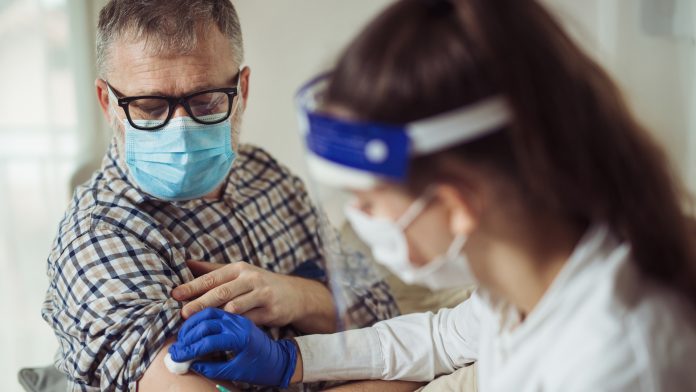
The benefits and efficacy of COVID-19 vaccines far outweigh the minimal risk of developing Bell’s palsy, researchers have said.
Following the first large-scale population-based study examining the link between the COVID-19 vaccines and the facial condition Bell’s palsy, researchers have concluded that the beneficial and protective effects of the inactivated COVID-19 vaccine far outweigh the risk of developing Bell’s palsy.
The study has been published in The Lancet Infectious Diseases journal.
What is Bell’s palsy?
Bell’s palsy is a form of temporary facial paralysis or weakness on one side of the face. It results from dysfunction of cranial nerve VII (facial nerve) which directs the muscles on one side of the face. In most cases, the condition resolves itself within six months without treatment and the chance of recovery is even higher (90%) if patients receive early treatment with corticosteroids.
To date, a small amount of Bell’s palsy cases have been reported in clinical trials of mRNA COVID-19 vaccines, but analyses of the association have so far been conflicting. In the USA, the Federal Drug Administration (FDA) determined that there was no clear causal association for the two mRNA vaccines, BNT162b2 (Pfizer-BioNTech) and the mRNA-1273 (Moderna) vaccines, but ongoing surveillance is recommended. Acute partial facial paralysis is reported as a rare side effect of both vaccines by the European Medicines Agency. Current prescribing information for CoronaVac (an inactivated vaccine) does not list Bell’s palsy as a rare adverse event, however, based on the findings from the study, approval has been obtained to include information on the potential association.
Medical recommendations always include the ongoing safety surveillance of any new treatment or vaccine to understand the prevalence of rare adverse events. This is only possible with very large population studies after the initial randomised controlled trials.
In the recent study, researchers analysed cases of Bell’s palsy related to the two approved vaccines in Hong Kong – CoronaVac and BNT162b2. The study looked at data from the Hong Kong drug regulatory authority pharmacovigilance system, which includes reports of adverse events logged by health professionals throughout the territory. Cases of Bell’s palsy were included in the analysis if they occurred within 42 days of the first or second vaccine dose, within the timeframe of the study. They also conducted a nested case-control study using a territory-wide electronic health record database including 298 Bell’s palsy cases and 1181 matched controls.
Between the period of 23 February 2021 and 4 May 2021, 28 clinically confirmed cases of Bell’s palsy were identified among the 451,939 individuals who received at least a first dose of CoronaVac (equivalent to 3.61 cases per 100,000 doses administered) and 16 cases were identified among the 537,205 individuals who received at least a first dose of BNT162b2 (equivalent to 2.04 cases per 100,000 doses administered).
By analysing data from 2010-2020, the researchers estimated the background risk of Bell’s palsy in Hong Kong – around 27 cases per 100,000 people, per year. Global estimates range from 15-30 cases per 100,000 people, per year. The nested case-control study found that receiving CoronaVac was associated with a 2.4 times increased risk of Bell’s palsy, whereas receiving BNT162b2 was not associated with a significantly increased risk.
Researchers concluded that, for every 100,000 people vaccinated with CoronaVac, an additional 4.8 people may develop Bell’s palsy. For BNT162b2, the increased risk was equivalent to an additional two cases per 100,000 people vaccinated – this finding may be attributed to underpower in the current study.
Future research
The researchers say that further studies with a sufficient sample size are needed to evaluate the association between Bell’s palsy and BNT162b2. They also note that a causal relationship between Bell’s palsy and vaccination in any individual cases cannot be determined from this study, and that the mechanism by which vaccination can – in very rare instances – lead to Bell’s palsy remains unclear. Other studies have identified rare cases of Bell’s palsy after other inactivated vaccines, such as influenza. A previous study, using the WHO Pharmacovigilance Database, reported no higher risk of facial paralysis following mRNA COVID-19 vaccination than with other viral vaccines, including influenza.
Lead author Professor Ian Chi Kei Wong, from The University of Hong Kong, said: “Our study suggests a small increased risk of Bell’s palsy associated with CoronaVac vaccination. Nevertheless, Bell’s palsy remains a rare, mostly temporary, adverse event. All evidence to date, from multiple studies, shows that the beneficial and protective effects of the inactivated COVID-19 vaccine far outweigh any risks. Ongoing surveillance, through pharmacovigilance studies such as ours are important to calculate with increasing levels of confidence the risks of rare adverse events.”
The authors note that the study is limited to patients with a new diagnosis of Bell’s palsy in Hong Kong, so further studies including patients with a history of the condition and patients in other regions are needed to confirm their findings. Further analyses are also required to understand whether the risk varies by sex or age.








